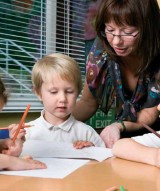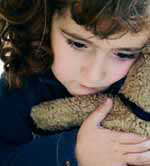Before children who may have experienced abuse and neglect can begin to learn, they must first feel safe and secure in the classroom
Ask any adoptive parent or foster carer to name one of the main difficulties they face and I guarantee most will say it is getting schools to understand the difficulties their children face in the educational environment. Working in partnership with any parent or carer is important, but for those whose children have experienced disturbed early trauma it is essential. This article aims to give some understanding of the challenges these children face and provides some helpful advice for supporting them.
 The definition of trauma is an external event in which there has been an actual or perceived threat to the life or personal integrity of self or others, combined with a response to the threat which includes fear, helplessness or horror. In this context we are talking about children who may have witnessed domestic violence, been physically abused, or neglected. Many of the behaviours displayed by traumatised children are a direct response to their early experiences. Young children who are shown little love, are not interacted with and do not have their basic needs met grow to believe that the world is a place filled with people who do not care.
The definition of trauma is an external event in which there has been an actual or perceived threat to the life or personal integrity of self or others, combined with a response to the threat which includes fear, helplessness or horror. In this context we are talking about children who may have witnessed domestic violence, been physically abused, or neglected. Many of the behaviours displayed by traumatised children are a direct response to their early experiences. Young children who are shown little love, are not interacted with and do not have their basic needs met grow to believe that the world is a place filled with people who do not care.
In certain cases, the best option for children is to be removed from their birth parents care and placed with foster carers, and whereas this would provide the child with those things they have missed it also teaches them another lesson – that you can be taken from everything you have ever known and be made to live with strangers. As adults we know that decisions such as removing a child from its neglectful or abusive parents is a painstakingly long and difficult process, but is sometimes the right thing to do. However, placing yourself in the child’s shoes paints a different picture. I am not saying that children should remain in that environment, but simply that we need to give huge amounts of consideration to the loss that the child will feel when they are taken from the only parents they have ever known.
The journey for many of these children does not end there, with many experiencing multiple foster placements, probably never feeling safe and always unsure of what might happen next. They learn that people disappear out of your life as quickly as they have arrived. As an adult in these circumstances, you would learn to be wary of new people and probably not waste your time getting too attached to them. You might be hyper vigilant and always watch out for danger or threats to your well being. You would probably become quite self-reliant and resist the help of others.
However, the common belief is still that these children should begrateful now they have wonderful foster carers, or even better a new adoptive mummy and daddy. Believing that this is enough to make everything okay is unrealistic and does not validate the child’s feelings.
Children who have experienced early trauma will have developed a range of strategies to enable them to survive. The behaviours you may see include:
• Being superficially charming
• Being indiscriminately affectionate with strangers
• Being overly demanding or clingy
• Asking persistent nonsense questions/incessant chatter
• Lack of cause/effect thinking
• Pseudo maturity
• Abnormal eating patterns
• Poor peer relationships
• Poor impulse control
• Avoiding eye contact
• Telling lies and/or stealing
• Low self esteem
• Show increased shame levels
• Difficulties with organisation
Dealing with such behaviours in the classroom can be draining and frustrating. When in this situation, I always recommend trying to think why and how this behaviour would have developed? For example, a young child who craved attention but did not receive it consistently could have learnt that talking incessantly and being demanding or clingy was more likely to result in some attention. On the flip side, some children may have given up in favour of self-soothing activities or shutting down.
 A first step to helping these children is to recognise the behaviour and understand its cause. Also remember that children may be functioning at a lower emotional age than their chronological age. They will often communicate at the emotional age they need to be in that moment, so you may find you have a child who acts very mature one minute and very toddler like the next.
A first step to helping these children is to recognise the behaviour and understand its cause. Also remember that children may be functioning at a lower emotional age than their chronological age. They will often communicate at the emotional age they need to be in that moment, so you may find you have a child who acts very mature one minute and very toddler like the next.
Following from this we must also teach the child to recognise the feelings they are experiencing. One way to do this is through the use of empathetic listening, whereby you comment, or ‘wonder’ out loud about the child’s behaviour eg: “I can see that you are getting quite close to my face when you are talking to me, I wonder if that is because you need to know I can see you. I can see you because as a teacher it is my job to know where you are”. It should be remembered that these are comments, and not questions, so do not expect a response from the child as that can add lots of pressure to their already anxious state.
Giving a child strategies they can use is also useful. Let them know that if they need attention from you they can come right out and ask for it. Allowing a child to feel comfortable with saying things like “I am scared you can’t see me at the back of the class” or “I am worried that if I am last in the lunch queue there will be nothing left for me” are huge steps in their development and feelings of trust that people will listen to them. However, encouraging a child to say these things does not mean you have to start moving them to the front of the dinner queue or similar, but it does enable you the opportunity to explain how the system works, for example why we have lunch registers and how this means every child who orders a lunch will get one.
Many traditional behaviour approaches focus on rewards and sanctions - where love, affection and praise is conditional on good behaviour. For children who already see themselves as ‘bad’, and’unworthy’, strategies like this only prove to reinforce this image of themselves. The popular technique of ‘time out’ compounds their sense of wrongness and shame. Imagine how being ‘sent away’ might effect a child who has already been rejected and abandoned numerous times in their life? The use of ‘time in’ (where a child is brought towards the adult) is a better option, and re-affirms that whilst what they have done may be unacceptable, they are not.
 There are certain curriculum topics that you should be mindful of which may cause difficulties for these children. Projects which focus on family trees, require baby photos, or cover subjects such as evacuation can all cause distress in some way. A child may not have photos from their early life, or for those who have they maytrigger difficult emotions. There are many ways to cover topics such as this without excluding the child, such as asking children to make up a fictional family tree, or one for a famous celebrity. Could they bring in photos from a recent family day out instead of requesting baby photos?
There are certain curriculum topics that you should be mindful of which may cause difficulties for these children. Projects which focus on family trees, require baby photos, or cover subjects such as evacuation can all cause distress in some way. A child may not have photos from their early life, or for those who have they maytrigger difficult emotions. There are many ways to cover topics such as this without excluding the child, such as asking children to make up a fictional family tree, or one for a famous celebrity. Could they bring in photos from a recent family day out instead of requesting baby photos?
We all experience fear of varying degrees and about different things, and we all knowhow hard it is to concentrate when we feel anxious and fearful. Imagine being scared of heights and being asked to write an essay whilst balancing on a tightrope. This is the reality for these children, only their fear is of people, of life, of being forgotten and abandoned. Only by calming their fears and building up trust will we give them the confidence and safety to learn.
Schools have a legal responsibility towards ‘looked after children’ but it is important to remember that a child’s needs do not change overnight should they be adopted. For education staff, simply being aware of these difficulties is a great achievement given the time constraints faced, but I would always urge further training wherever possible.
 Be vigilant for children who may conceal their true feelings…
Be vigilant for children who may conceal their true feelings…
As well as the children who ‘act out’ it is vitally important to recognise the needs of the children who have learnt to internalise their feelings. These children will have just as much fear, aggression, grief and shame but will keep it all locked deep inside, as their fear of rejection drives them to conform at all costs. You will often find that you are met with a blank face and witness behaviours that could be described as ‘odd’.
When trying to help these children you will need to monitor them very carefully to build up a picture of their feelings throughout the day. You can then aim to add in extra support around these times, but most importantly acknowledge how the child may be feeling, e.g. “I have noticed that you start to get really fidgety before we have a music lesson. Maybe you would like me to ask Mrs Smith to sit next to you at these times to help you feel better.”
Transitions periods and even the smallest change can be unsettling for a child who has never experienced security and stability, and who may have traumatic memories of change. Consider how you organise the day so that routines help build a strong sense of security and familiarity. Think about the most stressful times of day for the child and try to make yourself, or a teaching assistant available to offer additional emotional support.
Jennifer Jones runs Inspired Foundations (inspiredfoundations.co.uk), which provides support to both parents and professionals who live or work with children with trauma difficulties.
How To Use Books To Help Children Cope With Life
Ace-English
Use scaffolding to wean children off high levels of TA support
Ace-Kitchen-Manager
